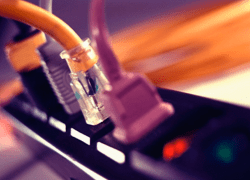July 15, 2013
Power Surges: They Can Zap More than Your Patience!
By paying a little attention to surge suppression now, you can avoid major headaches later on. It’s time to learn about power surge protection.


But on the flip side, power surges can be downright annoying…and costly! And if you own electronics like TVs and computers, appliances, like washer/dryer, mechanical equipment like furnace/boiler, then you could be especially vulnerable.
A power surge is a relatively long burst of high voltage that can cause substantial damage to sensitive electronic equipment and even major appliances. There are several external factors that can trigger the start of a power surge, including: lightning, downed trees, neighbors using heavy duty power equipment…even squirrels doing their “high wire” acrobatics.
Click here to visit the Applewood page for a short video on surge protection.
Of course, stuff like this happens all the time, so why aren’t there more power surges? Because lots of folks (and we hope you’re among them) have taken the proper precautions. Fact is, you’re far less likely to experience a power surge if your wiring is up to code and major appliances are properly grounded.
Next, you can greatly enhance your home defenses with surge protectors. There are basically two types:
- Exterior Surge Protector – is installed between your outside meter and your home and provides around-the-clock protection against high-voltage spikes before they can do damage.
- Interior Surge Protector – is installed inside your home to provide added protection for your more sensitive electronic equipment….think of it as a second line of defense for phones, computers, AV equipment, and more.
Of course, like anything else, not just any surge protector will do. That’s why Applewood recommends you insist on these minimum requirements:
- Joule Rating of 500 or Higher – This is the energy dissipation rate. The higher the rating, the better the protection.
- Response Time of 5 Nanoseconds or Less – Response time is literally that…the amount of time it takes a surge protector to react to the power surge. Anything at or under 5 nanoseconds should be sufficient.
- EMI/RFI Noise Filtration
How well wired is your home? If you’re even a little unsure, we encourage you to call Applewood today at (303) 232-6611 or schedule online at www.ApplewoodFixIt.com for a complete in-home wiring inspection. That way, we can take corrective action if and where needed, and before a major problem occurs.


